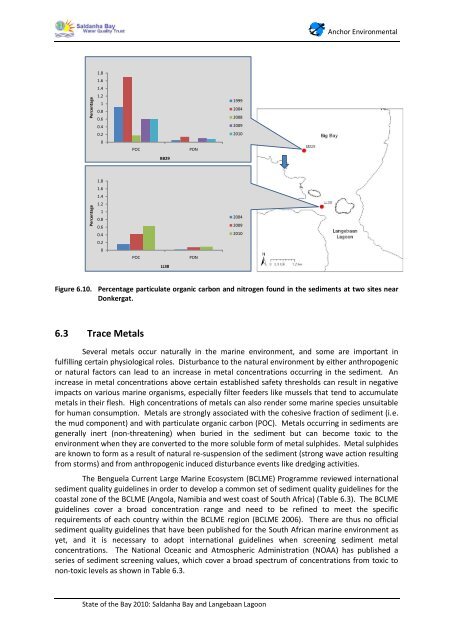State of the Bay Report 2010-Final - Anchor Environmental
State of the Bay Report 2010-Final - Anchor Environmental
State of the Bay Report 2010-Final - Anchor Environmental
You also want an ePaper? Increase the reach of your titles
YUMPU automatically turns print PDFs into web optimized ePapers that Google loves.
Percentage<br />
Percentage<br />
1.8<br />
1.6<br />
1.4<br />
1.2<br />
1<br />
0.8<br />
0.6<br />
0.4<br />
0.2<br />
0<br />
1.8<br />
1.6<br />
1.4<br />
1.2<br />
1<br />
0.8<br />
0.6<br />
0.4<br />
0.2<br />
0<br />
POC PON<br />
BB29<br />
POC PON<br />
LL38<br />
1999<br />
2004<br />
2008<br />
2009<br />
<strong>2010</strong><br />
2004<br />
2009<br />
<strong>2010</strong><br />
<strong>State</strong> <strong>of</strong> <strong>the</strong> <strong>Bay</strong> <strong>2010</strong>: Saldanha <strong>Bay</strong> and Langebaan Lagoon<br />
<strong>Anchor</strong> <strong>Environmental</strong><br />
Figure 6.10. Percentage particulate organic carbon and nitrogen found in <strong>the</strong> sediments at two sites near<br />
Donkergat.<br />
6.3 Trace Metals<br />
Several metals occur naturally in <strong>the</strong> marine environment, and some are important in<br />
fulfilling certain physiological roles. Disturbance to <strong>the</strong> natural environment by ei<strong>the</strong>r anthropogenic<br />
or natural factors can lead to an increase in metal concentrations occurring in <strong>the</strong> sediment. An<br />
increase in metal concentrations above certain established safety thresholds can result in negative<br />
impacts on various marine organisms, especially filter feeders like mussels that tend to accumulate<br />
metals in <strong>the</strong>ir flesh. High concentrations <strong>of</strong> metals can also render some marine species unsuitable<br />
for human consumption. Metals are strongly associated with <strong>the</strong> cohesive fraction <strong>of</strong> sediment (i.e.<br />
<strong>the</strong> mud component) and with particulate organic carbon (POC). Metals occurring in sediments are<br />
generally inert (non-threatening) when buried in <strong>the</strong> sediment but can become toxic to <strong>the</strong><br />
environment when <strong>the</strong>y are converted to <strong>the</strong> more soluble form <strong>of</strong> metal sulphides. Metal sulphides<br />
are known to form as a result <strong>of</strong> natural re-suspension <strong>of</strong> <strong>the</strong> sediment (strong wave action resulting<br />
from storms) and from anthropogenic induced disturbance events like dredging activities.<br />
The Benguela Current Large Marine Ecosystem (BCLME) Programme reviewed international<br />
sediment quality guidelines in order to develop a common set <strong>of</strong> sediment quality guidelines for <strong>the</strong><br />
coastal zone <strong>of</strong> <strong>the</strong> BCLME (Angola, Namibia and west coast <strong>of</strong> South Africa) (Table 6.3). The BCLME<br />
guidelines cover a broad concentration range and need to be refined to meet <strong>the</strong> specific<br />
requirements <strong>of</strong> each country within <strong>the</strong> BCLME region (BCLME 2006). There are thus no <strong>of</strong>ficial<br />
sediment quality guidelines that have been published for <strong>the</strong> South African marine environment as<br />
yet, and it is necessary to adopt international guidelines when screening sediment metal<br />
concentrations. The National Oceanic and Atmospheric Administration (NOAA) has published a<br />
series <strong>of</strong> sediment screening values, which cover a broad spectrum <strong>of</strong> concentrations from toxic to<br />
non-toxic levels as shown in Table 6.3.

















